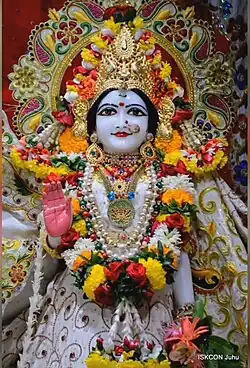| Maithili Mahopanishad | |
|---|---|
 | |
| Devanagari | मैथिलीमहोपनिषद् |
| IAST | Maithilī Mahopaniṣad |
| Title means | The Great Upaniṣad of Maithili (Sita) |
| Date | 10th to 11th Century AD [1][2] |
| Author(s) | Goddess Sita |
| Type | Vaishnava |
| Linked Veda | Atharvaveda |
| Chapters | 5 |
| Philosophy | Vaishnavism |
The Maithili Mahopanishad (Sanskrit: मैथिली महोपनिषद्, IAST: Maithilī Mahopaniṣad) is a Sanskrit text and is one of the minor Upanishads of Hinduism. Also found completely quoted in Valmiki Samhita chapter 5.[3]
Maithili Mahopanishad along with Sita Upanishad, Rama Tapaniya Upanishad, Valmiki Ramayan, Vasishtha Samhita, Agastya Samhita, Sadashiv Samhita, Bhardwaj Samhita, Vaishvanar Samhita, Bhusundi Ramayana etc.is very important and ancient popular texts in Sri Ram Vishistadwait Philosophy.[4]
Chapters overview
Maithili Mahopanishad[5] has total 5 chapters. This Upaniṣad is a dialogue between Goddess Sita and 7 Sages who were willing to know about the supreme reality, asked the questions:
ते होचुर्मातर्मोक्षकामैः किं जाप्यं किं प्राप्यं किं ध्येयं किं विज्ञेयमित्येतत् सर्वं नो ब्रूहि ॥
This translates to: O Mother, tell us what is worth chanting? what is worth attaining? what is worth meditating on? and what is worth knowing for one who desires salvation?
In Maithili mahopanishad Goddess Sita has been revealed as the supreme reality by the 7 Sages, they says:
भूर्भुवः स्वः । सप्तद्वीपा वसुमती । त्रयो लोकाः । अन्तरिक्षम् । सर्वे त्वयि निवसन्ति । आमोदः । प्रमोदः । विमोदः । सम्मोदः । सर्वांस्त्वं सन्धत्से । आञ्जनेयाय ब्रह्मविद्या प्रदात्रि धात्रित्वां सर्वे वयं प्रणमामहे प्रणमामहे ॥
This translates to: Sages said: In the earthly realm, the celestial space, and the heavenly realms, and in the seven continents on Earth, in the three worlds—Heaven, Mortal, and the Netherworld. All these, including space and the sky, reside within you. You embody joy, delight, exhilaration, and bliss. Oh ultimate embodiment of Dhatrī! bestower of Brahma Vidya to Lord Hanuman! Oh sustainer of all realms, Sri Sita! We bow to you repeatedly.[6]
This Upaniṣad also tells about the lineage of Shri Ram Mantraraj (i.e. Ram Shadakshar Mantra, rāṃ rāmāya namaḥ) revealing how that lineage passed from one to another, Goddess Sita says:
इममेव मनुं पूर्वं साकेतपतिर्मामिवोचत् । अहं हनुमते मम प्रियाय प्रियतराय । सर्वेद वेदिने ब्रह्मणे । स वसिष्ठाय । स पराशराय । स व्यासाय । स शुकाय । इत्येषोपनिषत् इत्येषा ब्रह्मविद्या ।
This translates to: Bhagvati Sita said: This six-syllabled mantra, 'The Ram Mantra,' was given to me by the Lord of Saket, imparting divine instructions. I passed this Mantra to my dear and beloved servant, Hanuman. Hanuman passed it on to the knower of Vedas, Brahma. Brahma passed it on Vashishtha. Vashishtha instructed Parashara. Parashara passed it on to Ved-Vyasa. Ved-Vyasa imparted it to Shukadeva Muni. This is the essence of the Upanishads, this is the knowledge of the ultimate truth.[7]
See also
References
- ↑ Paramlal Gupta (1973). Hindī ke ādhunika Rāma-kāvya kā anuśīlana. p. 46.
- ↑ Balbhadra Tivari (1976). Kavi-var Vishnu Das aur unki Ramayan. p. 54.
- ↑ Bhagavānadāsa, Vaishṇava (1992). Ramanand Darshan Samiksha (in Sanskrit and Hindi) (1st ed.). Prajñā Prakāśana Mañca. p. 12.
- ↑ Baldev Upadhyay, Acharya (1996). Sanskrit Vangmaya ka Brihat Itihas (in Hindi) (1st ed.). Lucknow: Uttar Pradesh Sanskrit Sansthan. p. 262.
- ↑ "Maithili Mahopanishat". sanskritdocuments.org. Retrieved 2023-12-06.
- ↑ Maha Upaniṣad, Maithili (1934). Kalyan Shakti Anka (1st ed.). Gita Press Gorakhpur. p. 211.
- ↑ Brahmachari, Bhagvaddas (1928). Kalyan Bhakta Ankha (1st ed.). Gita Press Gorakhpur. p. 195.
Further reading
Wikisource: Maithili Mahopanishad[1]
- ↑ "मैथिलीमहोपनिषद् - विकिस्रोतः". sa.wikisource.org (in Sanskrit). Retrieved 2023-12-06.